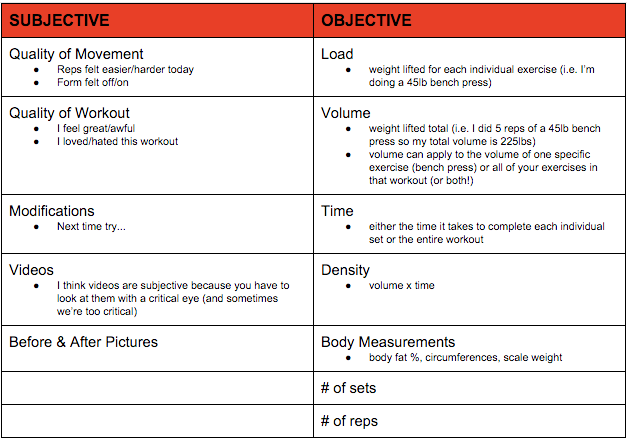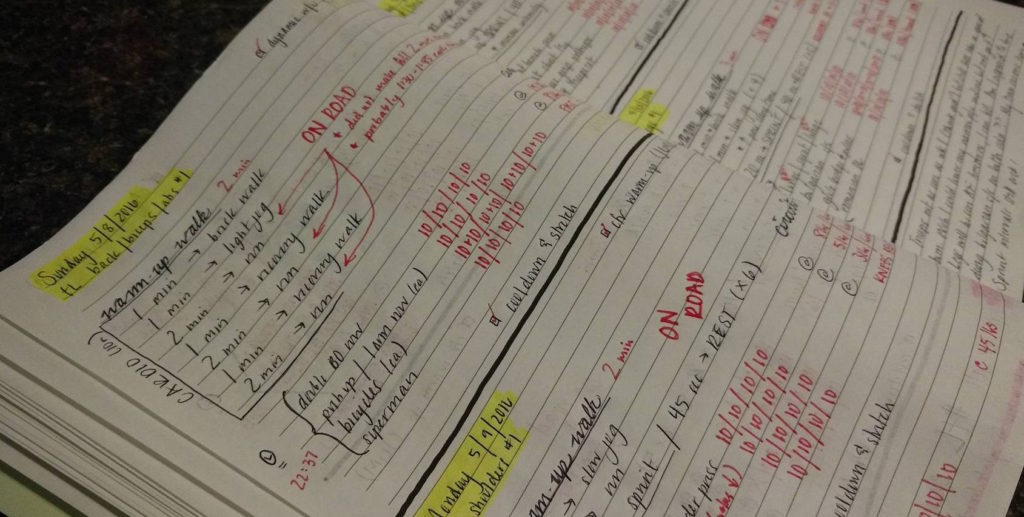I have an insane collection of notebooks. Don’t believe me?

All these notebooks house data of different sorts:
- Practice Plans
- League Notes & Business
- Meal Plans & Grocery Lists
- Business Brain Storming
- Notes from Books I’ve Read
- Future Blog Ideas
And these were just the ones that were IN REACH when I wanted to take a photo. Needless to say, I love data. There’s just something about collecting facts and figures that speaks to me (#nerdlanguage).
But this post isn’t {100%} about what a data glutton I am.
It is about how to incorporate data collection into your cross training.
See the notebook second from the bottom with the black binding? That’s my cross training notebook. And even more than dumbbells, kettlebells, barbells, or resistance bands, it’s my most important piece of equipment.
Why should you collect data?
Tracking your results is how you assess how well your experiment is working.
INTELLIGENT CROSS TRAINING BLUEPRINT
I’ve talked about this a little before in my over-the-top goal setting/target analogy. But…you need to create a target to have something to aim at (goal setting), you need to actually fire your shot (experimentation), and you need to look at where your shot landed on your target (feedback loop).
The actual act of collecting data isn’t that important. But what you do with the data afterward IS.
William Tell — yes, I’m using that example again — probably loosed a lot of arrows in the general eye region of his son’s face during practice before using what he saw to adjust his aim and pierce the apple instead. (I guess maybe that paragraph should have come with a GRAPHIC DEPICTIONS OF VIOLENCE warning. Next time…)
In the book Think Like a Freak, the authors offer this (paraphrased) example:
Imagine you’re the first human in all of human history to make bread. You have access to any ingredients that you need, but you can’t actually BAKE the break to see how it will turn out.
How long would it take you to create a recipe that even remotely resembled bread?
That’s the importance of collecting data. Fixing small problems as they arise rather than fixing no problems and getting nowhere.
The 2 Types of Data
But we’re not talking about arrows and apples or the importance of baking your bread. We’re talking about cross training!
There are a lot of different things you can track when you’re looking at your workouts, but they fall into two main categories: subjective data and objective data. Or qualitative and quantitative, if you prefer.
SUBJECTIVE DATA (or qualitative data) is data based mostly on how you feel.
- Was this workout easier than the last time I did it?
- Does this weight feel like it goes up smoother this time than it did last time?
- Am I breathing harder now?
Subjective data may not sound important, but it is certainly valuable, so don’t knock it. You want to feel less winded or exhausted when you’re skating, right?
And subjective data can show you important correlations like: workouts feel more difficult for me the week before my period starts or I really shouldn’t eat gluten right before I workout because I couldn’t even reach my baseline data. (By the way, I will take your extra gluten. Just pour it directly into my mouth.) It’s data based on the quality of the experience.
OBJECTIVE DATA (or quantitative data) is data based on numbers.
Cold hard facts.
- Am I using more weight today?
- Am I doing more sets or reps today?
- Do I weigh less/more than I did the last time I checked?
- What’s my body fat measurement?
- What are my circumference measurements?
- What does my fitness testing data say?
Objective data gives you a concrete view of whether you are actually improving over time. It’s data that can actually be quantified and counted.
When it comes to deciding how to track your own results, don’t favor collection of one type of data over another. They both offer very important markers of whether your program is working.
Here are some specific things you can track within each data category:

There are probably multiple other pieces of data you could collect in one or both of these categories, but these are some of the most basic. Collecting this information is all we’re worried about right now.
How do I collect data?
If you’re not an absolute data head, like me, then the idea of collecting all that information probably seems a bit…overwhelming. But you can do it!

Start simple. Grab a composition notebook and a pen. This will be your cross training log.
Got them?
Good. You’re ready to collect data.
Always go into your cross training log and the idea of collecting data with this thought in mind: When in doubt, write it out.
- If you planned on doing a kettlebell workout, but only had dumbbells handy — write it down.
- If you used a blue resistance band or a red one — write it down.
- If you change weight in the middle, if you use a non-conventional grip, if you were distracted by that hot chick on the treadmill — write it down.
At this point you might be thinking, “Great Prime. But HOW do I write it down.” The answer is (as you might be catching on) however works for you.
But I get it, I didn’t keep a cross training log when I first started because I just didn’t know what to write down or how to organize it. I just wanted someone to tell me or show me.
You got it:

Here is an example of a recent workout in my cross training log (or strength journal or whatever you want to call it).
I started with a dynamic warm-up — which is the same one that I always do. So I just checked it off in the upper right hand corner of the page.
The second section is interval training. In this case, I was alternating running and recovery walking for time. I also made a note of where I completed my running (on the hilly ass road in my neighborhood) and that I didn’t complete a full 2 minutes of running during each interval. (My note actually says I made between 1:30 to 1:45 each run.)
The third section is strength training. This is done in a circuit — which is written on a part of my log you can’t see. And to the left of the exercises, I wrote down the total time that the circuit took me. After each exercise name, there is a the number of sets that I completed during each rep. For example, with double bent-over rows it says 10/10/10/10 which means that I completed 4 sets of 10 reps each in a circuit style.
After the exercise description and rep/set data, I’ve listed weights (if there were any) followed by any subjective data. I was lifting 15lbs per hand for the double bent-over rows and 8lbs per hand for the pushups/rows with the additional note that I had to do them “on knees”. You can also see that I listed “FAST + slow” next to the bicycles reps and sets which means I did 10 fast and 10 slow for each set.
The cooldown and stretch are another checkbox, mostly because my stretching is always different based on which muscles I’ve been working.
This is the way I record my workout data.
You might want to record more (or less) and that’s great! But if you’re stuck on how to get started or what to write down, you can organize it this way until you get a feel for what you like and what works for you.
Most importantly…
Don’t shirk your data duties. Incomplete data is WORSE than no data at all.
And while the actual collection of data may not float your boat, what you can do with it once you have it is pretty damn cool.
Want more?
If you’re interested in more exclusive content, access to my FREE resource library, and the slightly weird workings of my inner mind, you can sign up for the Iron Octopus Fitness email list HERE. Wherein I harass you weekly with all things intelligent cross training, mindset, and…other.
